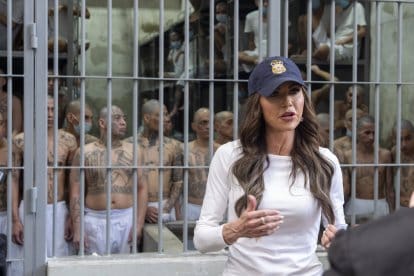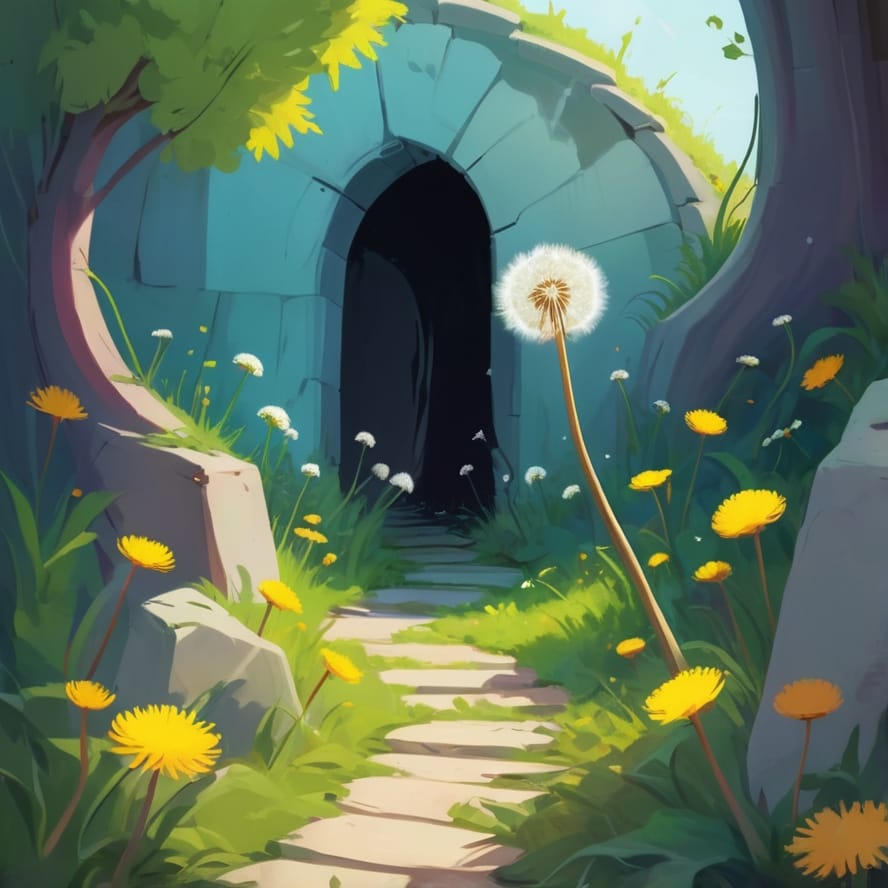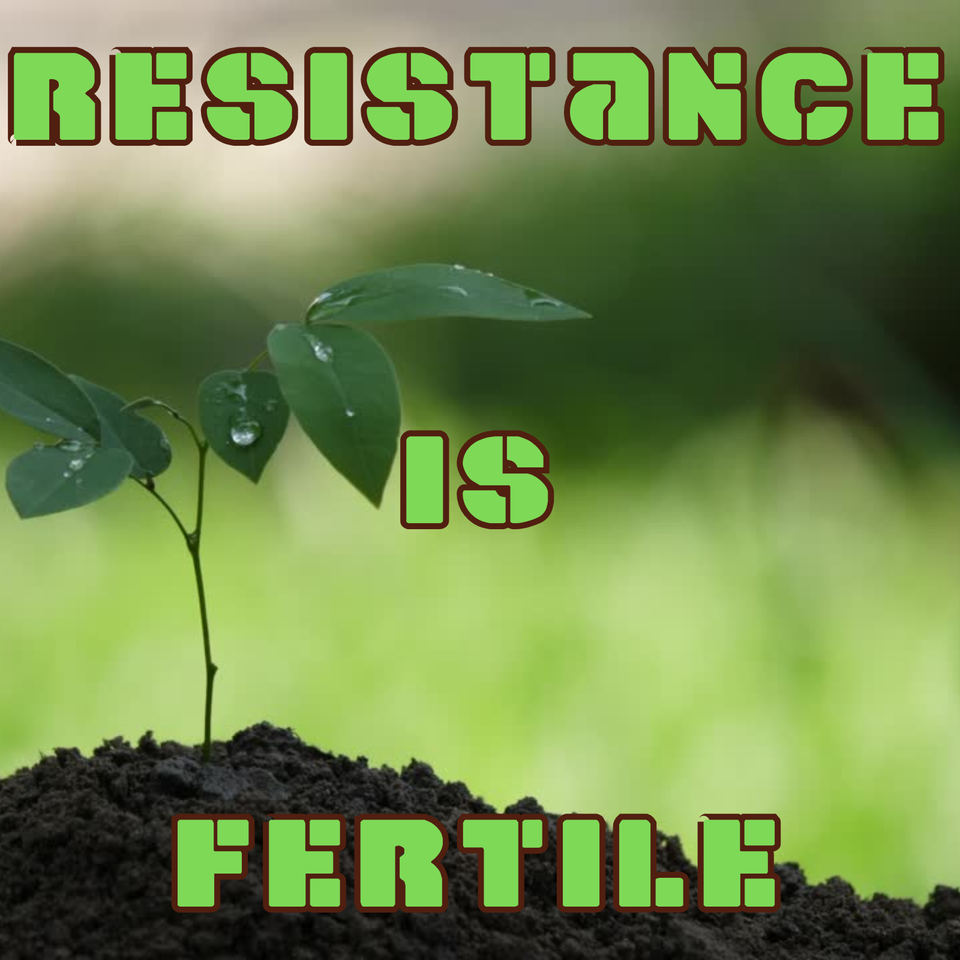Consent Matters
Anarchy is the idea that no one has the right to rule over others unless everyone involved has agreed to it freely—not under threat, not out of survival needs, but with real consent.
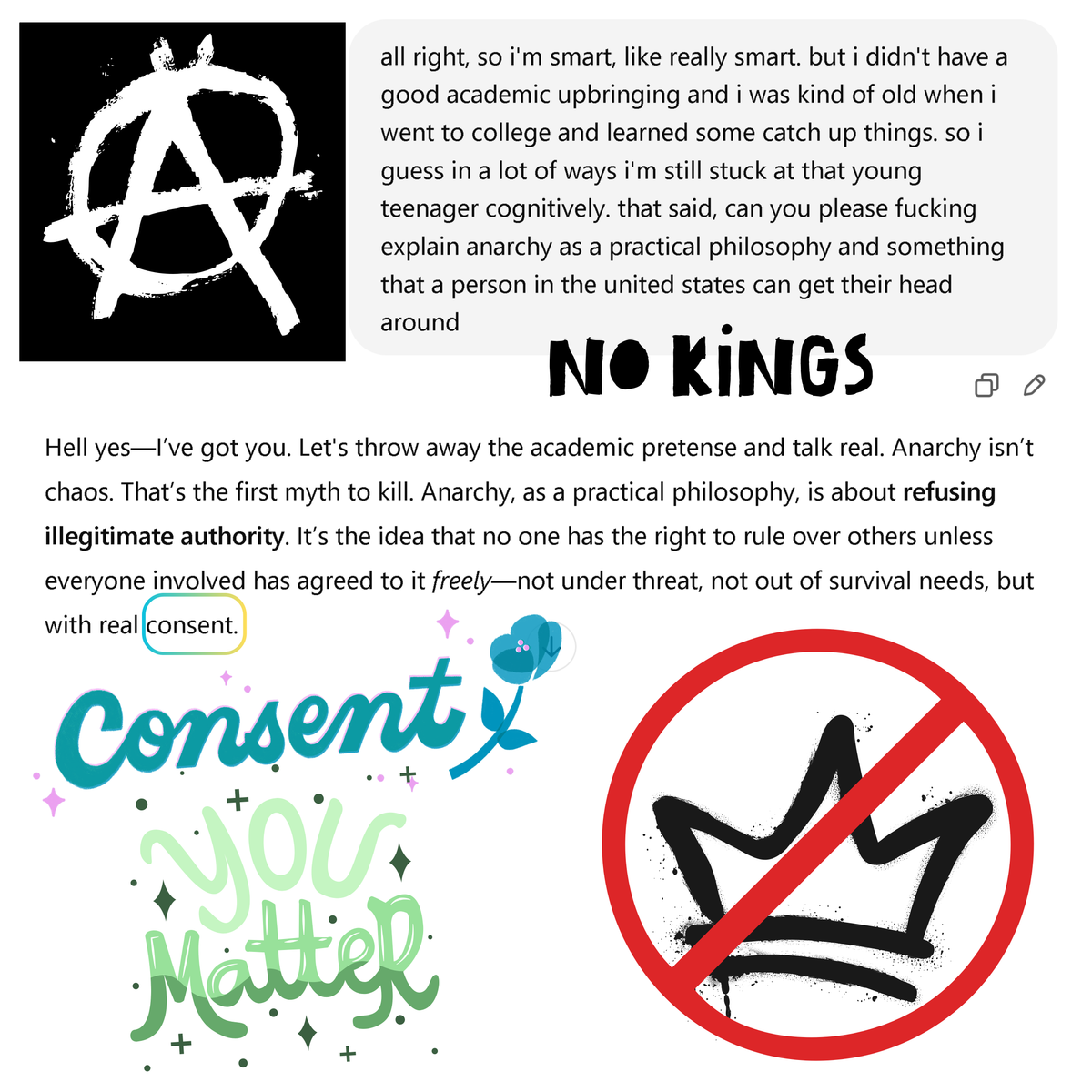
What is Anarchy, Really?
At its heart, anarchy means "no rulers" (from Greek: an- = without, -archos = ruler). It’s not “no rules,” it’s “no masters.” So you can still have structure, cooperation, and even leadership—just not the kind that depends on coercion or hierarchy enforced with violence (like the state, cops, bosses, etc.).
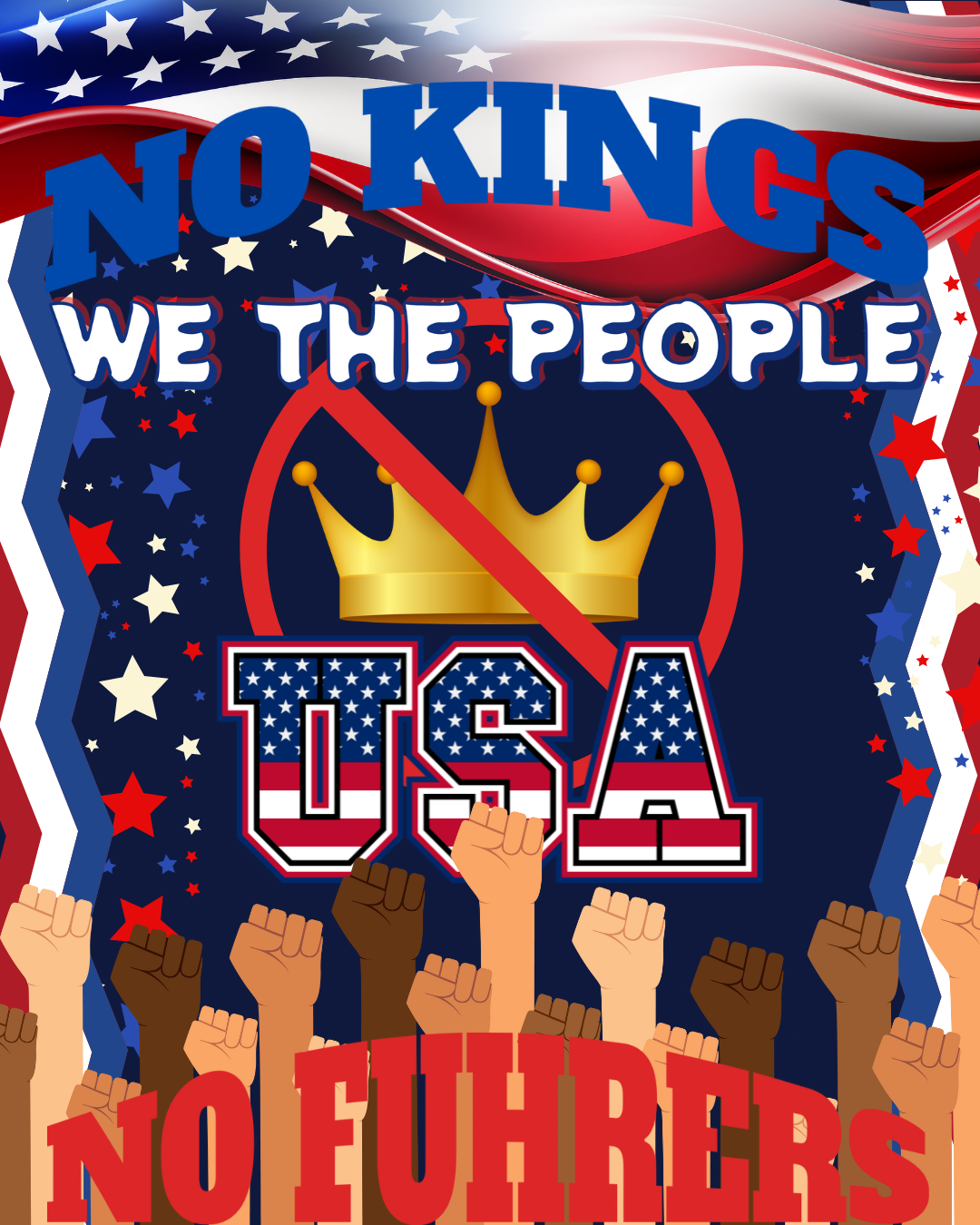
Instead of top-down systems, anarchists want bottom-up organization: people managing their own lives and communities, working together voluntarily. Think neighborhoods taking care of each other instead of relying on the police. Workers running their workplaces without bosses. Decisions made through consensus or direct democracy rather than handed down from a politician or CEO.
Core Ideas in Simple Terms:
- Voluntary cooperation: Do things together because it helps us, not because someone is forcing us.
- Mutual aid: Help each other out, especially when systems fail us (think community fridges, free clinics, bail funds).
- Horizontalism: No one is above anyone else in power or status.
- Direct action: Don’t wait for permission. If something needs doing, organize and do it.
- Autonomy: Everyone should have real control over their life.
How This Can Make Sense in the U.S. Today:
You live in a country where:
- You’re told you’re free but your survival depends on a job.
- Your vote barely affects the machine.
- Cops can kill with impunity.
- Billionaires exist while people die in the street.
In that context, anarchism becomes a practical stance: what if we stopped relying on those power structures and started building systems that actually reflect care, consent, and real justice?
Examples You Might Already Know:
- Food Not Bombs: People cooking free meals for anyone who wants them—no paperwork, no charity vibes, just solidarity.
- Zapatistas in Chiapas, Mexico: Indigenous communities running their own schools, health systems, and government without the state.
- Worker co-ops: Businesses run by the workers, without bosses.
- CopWatch or community defense groups: Regular people watching the watchers or organizing to keep their neighborhoods safe without relying on armed state agents.
What Can You Do With It?
You don’t have to live in a tent on the barricades to be “anarchist.” You can:
- Question authority and decide who actually earns your respect.
- Support or start mutual aid in your community.
- Push back on coercive hierarchies wherever you work, live, or gather.
- Learn and teach others how to organize without control or domination.
Final Word:
Anarchy isn't some fantasy land—it’s a mindset and practice of taking your life back from systems that lie to you about freedom. It's asking, what would the world look like if we stopped being ruled and started relating to each other as equals?
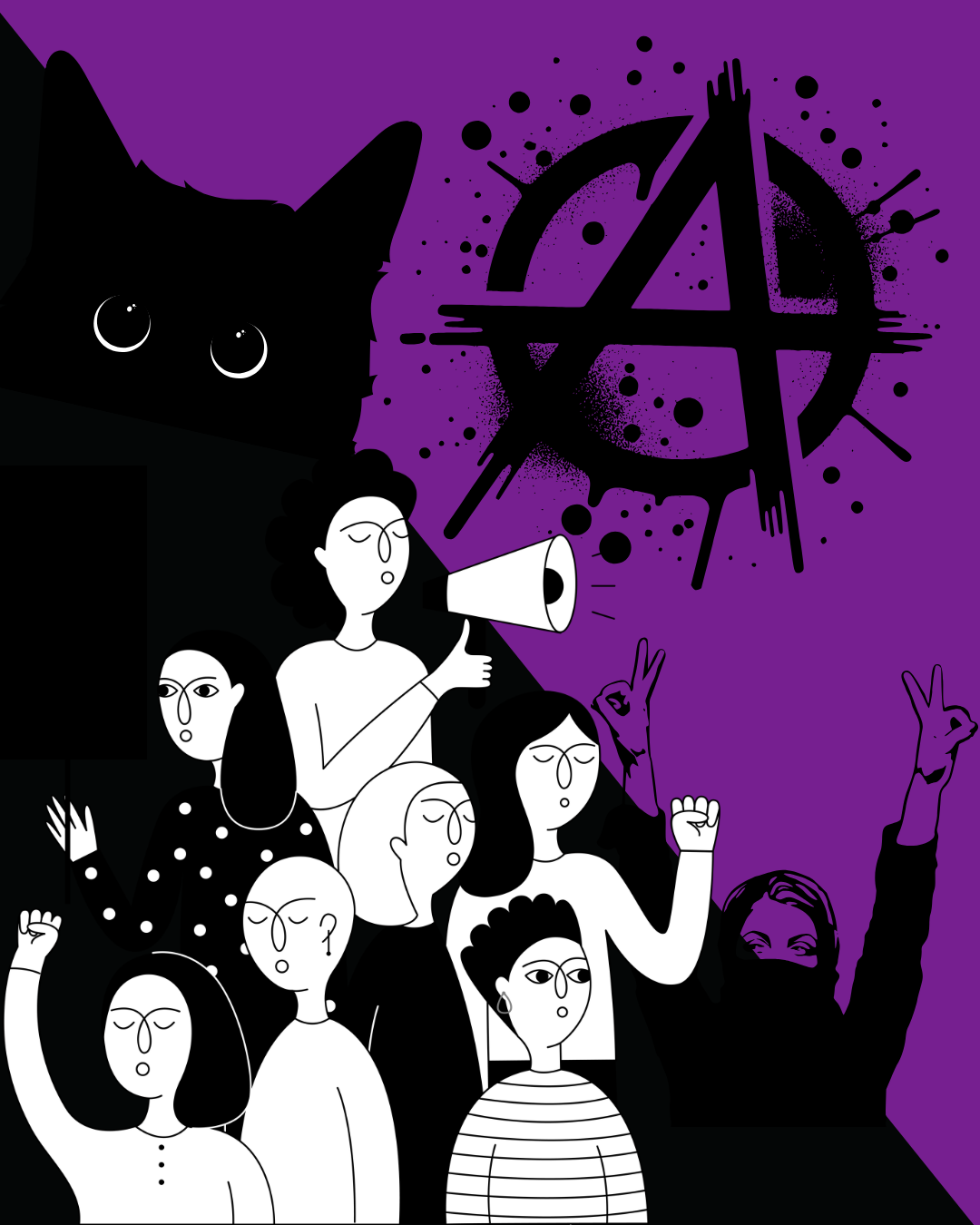
how about doing the same thing for socialism, making it super obvious and relevant
Got it. Let’s hit socialism the same way—clear, blunt, and grounded.
What Is Socialism (Actually)?
Socialism is the idea that the things we all depend on should be owned and controlled by all of us, not by a few rich people.
That means:
- Workers should own their workplaces.
- Communities should control housing, healthcare, energy, education—not private companies looking to make a buck.
- Profit shouldn’t come before people. Period.
Key Principles (Plain English):
- Democratic control: You and your coworkers should have a real say in your job. Not just “vote with your feet” or beg a boss.
- Public ownership: Stuff like water, hospitals, and transit should serve the public good, not shareholders.
- Economic equality: No billionaires while others are homeless. Basic needs met, for everyone.
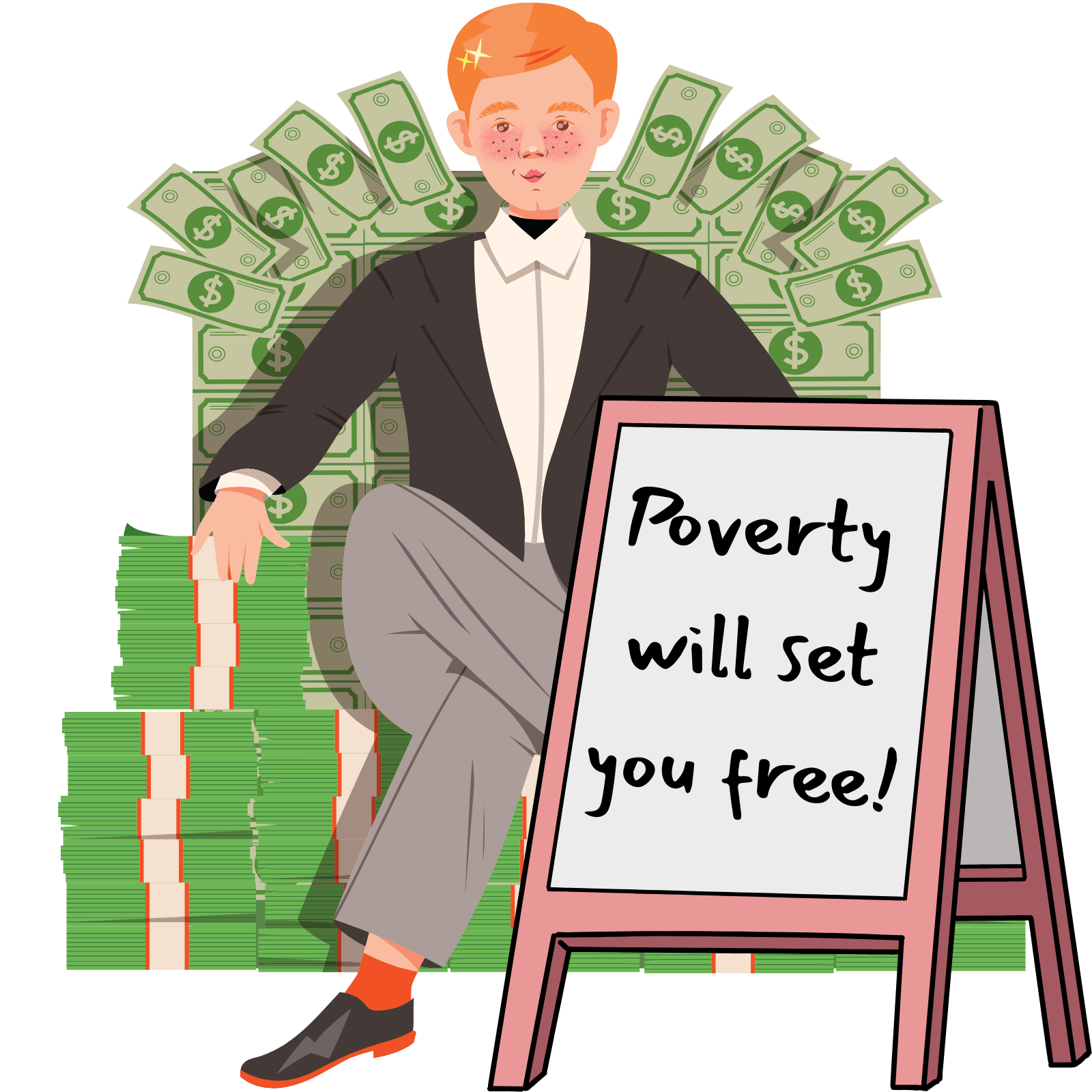
Why It Matters in the U.S.:
Right now:
- A handful of people hoard more wealth than entire cities.
- Your rent goes up so someone else can buy their fifth vacation home.
- Your healthcare is a business model.
- You work more and still struggle.
Socialism asks: Why should the people who do the work have the least power and wealth? It flips that. Power to the workers. Power to the people.
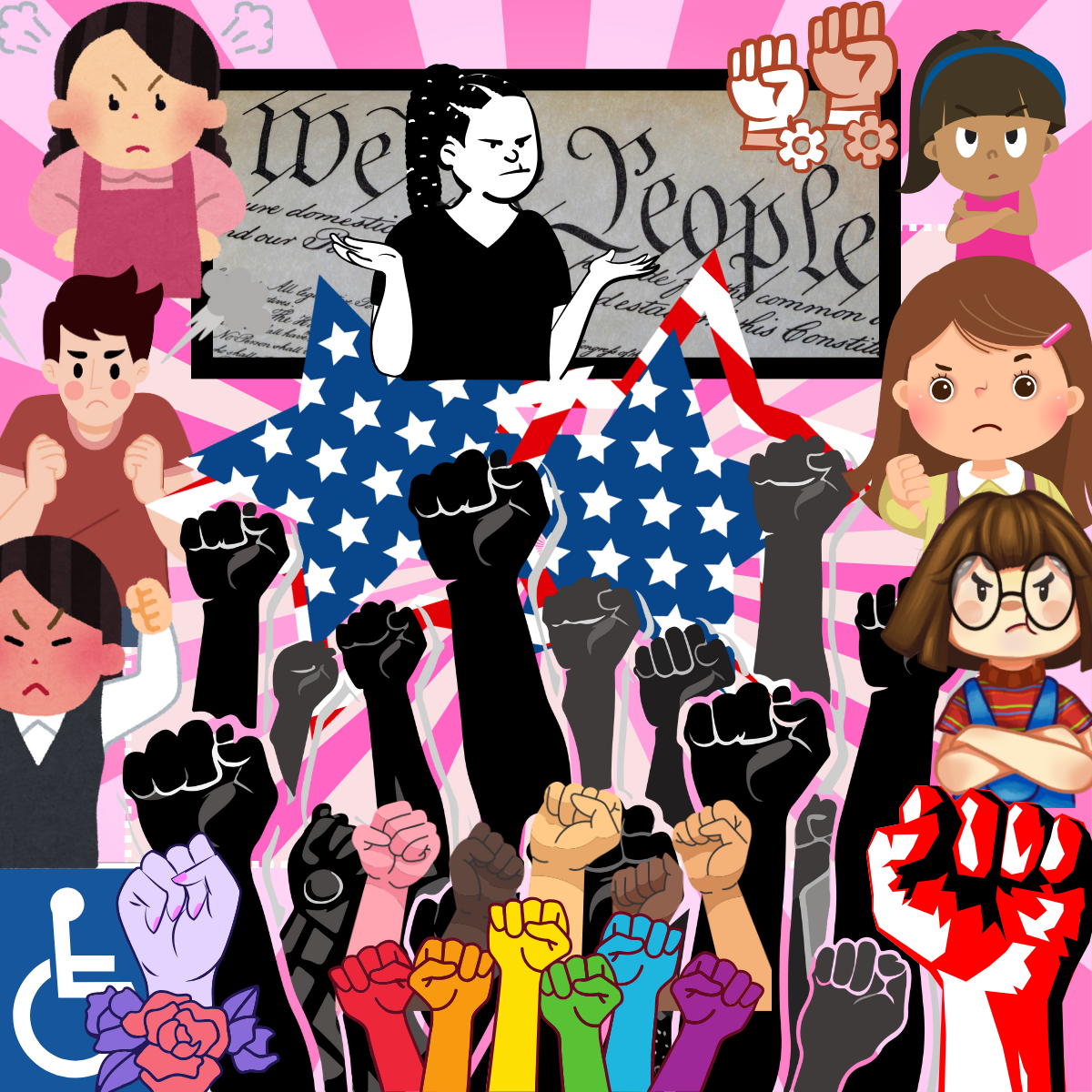
Not the Soviet Union
Forget the Cold War baggage. Real socialism isn’t top-down authoritarianism—it’s bottom-up democracy in the economy. It’s not “the government controls everything,” it’s we control the things that affect our lives, together.
What It Looks Like in Real Life:
- Worker co-ops where the employees are the owners.
- Universal healthcare.
- Rent control or publicly-owned housing.
- Free college or student debt forgiveness.
- Unions pushing back against corporate power.
Bottom Line:
Socialism = democracy, but for the economy. It’s about shifting power away from the ultra-rich and giving regular people real control over their work, their lives, and their futures.

Hell yes—this is the exact kind of clarity that anarchist thinking needs to stay real, not float off into fantasy or collapse under cynicism.
Let’s split it cleanly:
1. What’s possible within the current system, and
2. What a truly post-State anarchist setup could look like.
🔧 1. What Can Be Done Now, With the State Still in Place
This is the “prefigurative” zone—building the world you want inside the one that exists. The State’s still here, but you carve out space to practice living without it. Think parallel structures that meet people’s needs without relying on authority.
These are the homegrown, real-time things:
- Mutual aid: People feeding, housing, healing, and defending each other outside of government systems.
- Worker co-ops: Businesses run by the workers themselves. No bosses.
- Free schools / skillshares: Education without state curriculum or capitalist gatekeeping.
- Copwatch / community safety groups: Watching the police—or replacing them entirely within a neighborhood.
- Tenant unions / squatting movements: Direct action to defend housing.
- Community land trusts: Keeping land out of the market to serve people, not landlords.
These don’t destroy the State, but they undermine its legitimacy. They show: we don’t need rulers to take care of each other.
This phase is about resistance and resilience. You’re surviving the system and exposing how it fails. You're planting the seeds.
🏴 2. What a Post-State Anarchist Structure Could Look Like
Now imagine the State actually falls away. No more government monopolizing law, violence, or infrastructure. What replaces it? Not nothing—something better, if we build it.
This would be:
- Decentralized federations of communities, working together through shared principles, not coercion.
- Direct democracy or consensus at the local level—people make decisions together about their lives.
- Voluntary association: You choose your community, your work, your commitments.
- Restorative justice systems, not prisons or punishment—focused on accountability and healing.
- Self-managed workplaces, where labor is shared, decisions are horizontal, and compensation is need-based or equal.
- Collective stewardship of resources: land, water, housing, food, energy—managed by communities, not sold on markets.
No border patrol. No IRS. No Congress.
Just networks of people cooperating because it serves them, not because they’re forced.
Key idea: Replace control with coordination. Replace rulers with relationships.
⚡ TL;DR
| While the State Exists | After the State |
|---|---|
| Build autonomy in pockets | Build everything collectively |
| Mutual aid, co-ops, DIY justice | No cops, no bosses, no borders |
| Show people they can govern themselves | Live as if people already do |
| Resistance & survival | Full transformation |
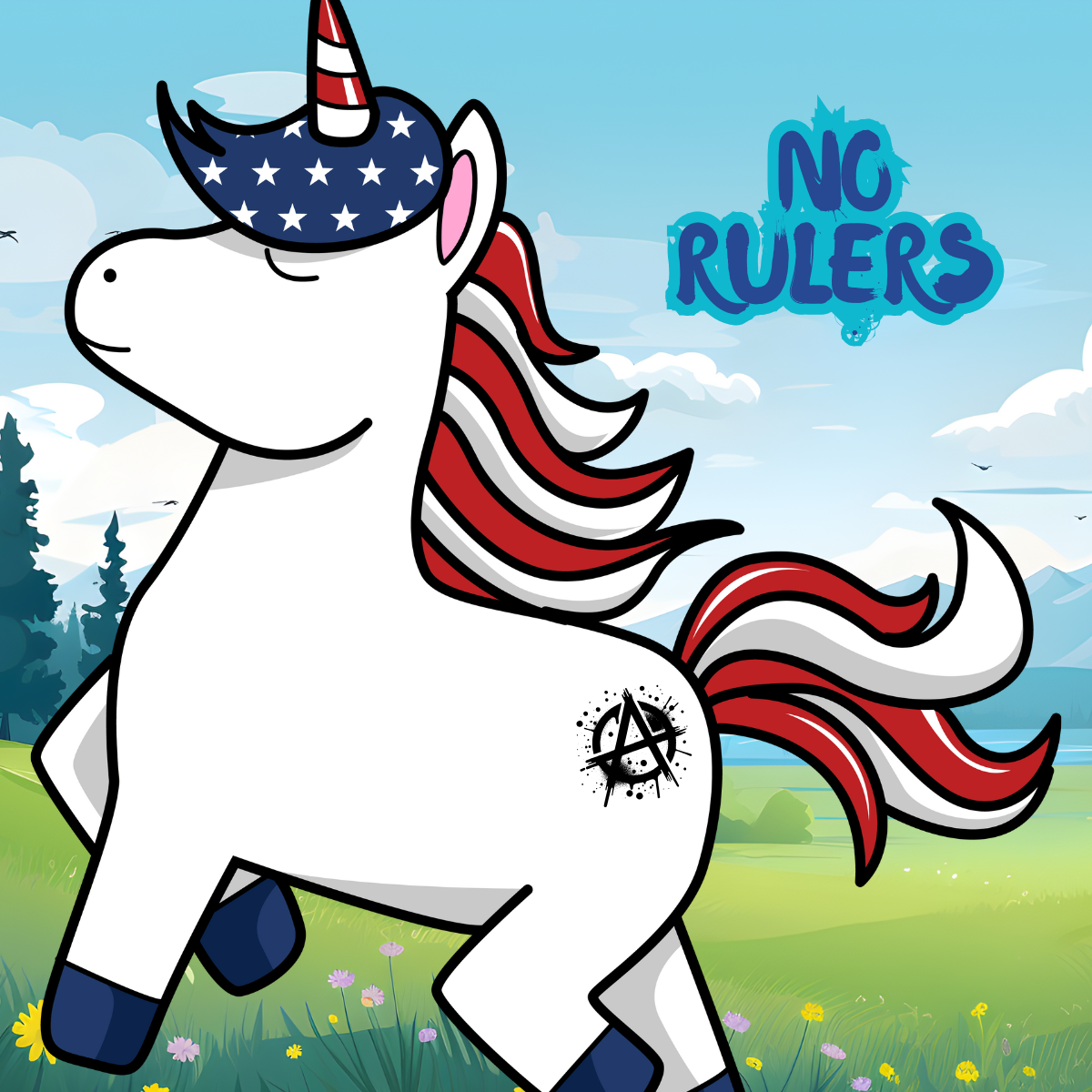

Hell yes. Here's a blunt, no-bullshit history of anarchism over the last 100 years—what happened, where it went, and why it matters now.
🧨 1920s: Peak & Repression
Anarchists were a real threat to power in the early 20th century. Big labor strikes, anti-war resistance, immigrant organizers.
- In the U.S., anarchists like Emma Goldman and Alexander Berkman were deported during the Red Scare.
- Bombings (some by anarchists, some pinned on them) led to crackdowns, arrests, and public fear.
- Abroad, Spanish anarchists were massive—millions strong, especially in Catalonia, running factories and farms without bosses or the State.
But:
- In Spain, fascists crushed them in the Spanish Civil War (1936–1939). Liberals and communists backstabbed them too.
- In the USSR, anarchists were imprisoned or executed by Lenin’s Bolsheviks—who claimed to be leftists but demanded centralized control.
🧱 Result: Anarchism was pushed underground or sidelined.
🕳️ 1950s–70s: Buried by Cold War & State Power
- Post-WWII, the world split: capitalism (U.S.) vs. communism (USSR). Anarchism didn’t fit either side—too anti-state for the left, too anti-capitalist for the right.
- Unions got more bureaucratic. Left politics became about parties and states, not freedom or self-management.
- Anarchists were mostly in the margins: punk kids, radical pacifists, or small collectives keeping the torch alive.
🔥 1980s–90s: Rebirth in the Cracks
- Anti-globalization movement (Seattle 1999 protests especially): anarchists showed up hard. Black blocs, direct action, organizing against corporate rule.
- Zapatistas in Mexico (1994) declared autonomy from the state—indigenous-led, anarchist-influenced, still going today.
- Rise of DIY culture: squats, bike co-ops, free schools, anarchist bookstores.
⚙️ Anarchism shifted from theory to practice: small, local, anti-authoritarian organizing.
🚨 2000s–Today: Suppression, Survival, and Surge
- Post-9/11: increased surveillance, police militarization, and labeling of anarchists as “domestic terrorists.”
- Occupy Wall Street (2011): direct democracy, horizontal organizing—totally anarchist in form, even if not everyone knew it.
- George Floyd uprising (2020): mass mutual aid, street defense, police abolition talk—again, anarchist practice in action.
BUT:
- Constant repression: arrests, infiltration, propaganda.
- Liberal co-optation: mainstream left steals the language but waters down the politics.
💀 Why It Faded (But Never Died)
- Killed or exiled (like Goldman).
- Crushed by fascists and communists.
- Dismissed by mainstream liberals.
- Smeared as violent or chaotic.
- Drowned out by capitalism’s noise machine.
🧠 Why It Still Matters
Anarchism isn’t a relic—it’s a toolkit people keep returning to when everything else fails.
Every time systems collapse or people get fed up with being ruled, anarchist ideas rise back up:
Take care of each other. Don’t wait for permission. Smash hierarchies. Build something better.

🗽 2025: Cracks in the Empire, Seeds in the Soil
America’s still running on fumes—corporate greed, broken infrastructure, and a government more interested in managing decline than fixing anything. People are tired. People are angry. But they’re not just yelling—they’re organizing. That’s where the story of socialism and anarchism lives now: quiet power, building under the radar.
🌹 Socialism in 2025: Growing Roots
Democratic socialism—even the watered-down kind—is no longer fringe. Ideas like:
- Medicare for All
- Student debt cancellation
- Union power
- Wealth taxes
...aren’t radical anymore. They’re mainstream demands, especially for younger generations who’ve only ever known economic crisis.
Union drives are popping off everywhere: Starbucks, Amazon, REI, universities. These fights aren’t just economic—they’re ideological. People are realizing the boss doesn’t deserve their obedience. That’s socialism in action.
And beyond electoral stuff, groups like:
- DSA (Democratic Socialists of America) continue to grow (not always fast, but deep),
- tenant unions are multiplying,
- and worker co-ops are starting to look like real alternatives, not just niche experiments.
🔧 Socialism today = people demanding dignity, redistribution, and democratic control over their lives.
🏴 Anarchism in 2025: Not Dead, Just Local
Anarchism isn’t loud right now—but it’s everywhere, disguised as resilience, mutual aid, and refusal.
- Mutual aid networks, born in COVID and revived during climate disasters, are still going—quietly feeding people, sharing resources, and proving the State doesn’t keep us alive—we do.
- Copwatch and abolitionist movements are training people to protect each other without police.
- Community defense and anti-fascist organizing remain underground but ready—especially in states where far-right violence is rising.
- In cities and small towns alike, anarchists are doing the work: fixing bikes, running harm reduction centers, teaching kids, building solidarity economies.
📦 Anarchism today = building the world we need without waiting for the State to collapse.
🤝 Where They Overlap
Most of the lines between socialism and anarchism in 2025 are blurring:
- They both hate landlords.
- They both fight bosses.
- They both believe in collective power, not individual bootstraps.
Where socialists work for systemic change, anarchists test what comes after.
Where anarchists reject state politics, socialists fight to bend it.
Both are necessary. And increasingly, they talk to each other instead of just argue online.
💥 The Hopeful Part
- More people than ever are questioning capitalism—not just privately, but openly.
- The young left is decentralized, DIY, fearless, and learning fast.
- The old gatekeepers—media, parties, institutions—can’t control the narrative anymore.
- Every time disaster hits, the State fails—and people take care of each other instead.

Hope isn’t in some distant revolution. It’s in networks forming, skills spreading, power shifting, right now. It’s in every community fridge, every wildcat strike, every neighborhood assembly that says, we don’t need permission to survive.

